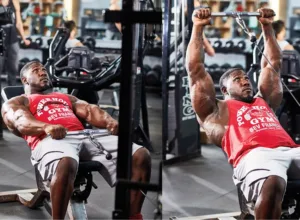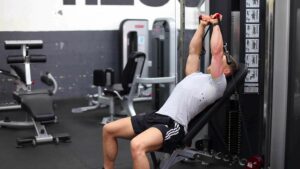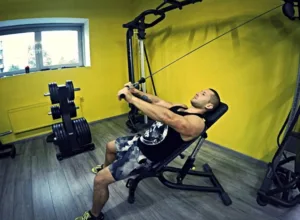The cable incline pushdown is a targeted exercise designed to isolate and strengthen the triceps brachii, the muscle group on the backside of your upper arm. This exercise offers several advantages over traditional free-weight tricep movements, making it a valuable addition to your arm-training routine.
Need more variety in your back training routine? The cable incline pushdown is a unique and effective exercise that’ll help to develop the lats.
- Target Muscle Group: Latissimus Dorsi
- Type: Hypertrophy, strength, stability
- Mechanics: Isolation
- Equipment: Cable machine
- Difficulty: Beginner
Muscles Worked
Latissimus Dorsi
Deltoid Posterior
- Related Articles: Ultimate Workout “To Build A V-Taper Back” With Those Exercises
Teres Major
Muscles Targeted
The primary muscle targeted by the cable incline pushdown is the triceps brachii, specifically the long head, medial head, and lateral head. The long head plays a major role in extending the elbow and contributes to arm flexion at the shoulder. The medial and lateral heads help with elbow extension and provide some stability to the joint.
Additionally, the incline position engages the core muscles to maintain proper posture throughout the movement.
Benefits of Cable Incline Pushdowns
- Isolation: Compared to free-weight tricep exercises, the cable machine allows for a more isolated movement, minimizing involvement of secondary muscle groups and maximizing tricep activation.
- Constant Tension: The cable provides constant tension throughout the entire range of motion, leading to increased muscle growth and definition.
- Mind-Muscle Connection: The controlled movement of the cable machine allows for a better focus on the triceps, facilitating a stronger mind-muscle connection.
- Variation: The cable machine offers versatility, allowing for adjustments in handle type (straight bar, rope attachment) and hand position (neutral grip, close grip) to target different aspects of the triceps.
Check Out Our List Of The Best Supplements For Building Muscle, Shredding Muscle, Recovery, And Great Health, and Wellness Products! Purchase ifbnewsfeed.org‘s apparels Here: ifbnewsfeed.org

 Cable Incline Pushdown – Step-by-Step Guide
Cable Incline Pushdown – Step-by-Step Guide
- Set Up: Adjust the incline bench to an angle between 30-45 degrees. Attach a straight bar or rope handle to the low pulley of a cable machine. Sit on the incline bench with your back pressed firmly against the backrest and feet flat on the floor. Grasp the handle with an overhand grip (palms facing down) shoulder-width apart.
- Starting Position: Brace your core by engaging your abdominal muscles. Extend your arms overhead so that the handle is directly above your shoulders with your elbows slightly bent. This is the starting position.
- Lowering Phase: Maintaining a slight bend in your elbows and a fixed upper arm position, slowly lower the handle down towards your chest. Focus on squeezing your triceps as you lower the weight. Keep your torso upright and avoid arching your back.
- Peak Contraction: At the bottom of the movement, when your forearms are nearly parallel to the floor, hold the contraction for a second, feeling the squeeze in your triceps.
- Lifting Phase: Squeeze your triceps to raise the handle back to the starting position directly above your shoulders. Focus on using your triceps to lift the weight, not swinging your body.
- Repetitions: Complete 8-12 repetitions for 3 sets.
How To Do The Cable Incline Pushdown
- Place the bench next to the cable machine so that your head will be close to the pulley as shown in the video, and adjust it to about a 45-degree incline.
- Set the pulley with the bar attached low enough to where you can grab it comfortably but high enough to where you’re able to maintain tension in the cable while seated with arms extended overhead.
- Grasp the bar with hands about shoulder-width apart, keep your shoulders back, chest up, and engage your lats.
- With your elbows just slightly bent, drive your elbows down until your arms are at torso level.
- Raise your arms back up slowly until they’re almost extended overhead and repeat the exercise for the desired reps.
- Build Strength In Your “Legs And Back” With This Great Exercise
- How “The Close Grip Lat Pulldown Exercise” Pumps Your Back And Your Biceps At The Same Movement
Cable Incline Pushdown Tips
- Always use a weight that you can handle for at least 6-8 reps with good form. Anything heavier and you’re not maximizing the movement, by compromising proper form.
- Do not set up the pulley too high or low. Set it up just low enough that allows you to get full extension of the arms overhead. This simply makes things easier especially when you have to release the weight at the end of the set.
1. Straight-arm pushdown
2. Barbell pullover
3. Machine lat pullover
How To Incorporate The Cable Incline Pushdown Into Your Training Routine
Sets/Reps
Tips for Proper Form
- Maintain Upper Arm Position: Throughout the movement, avoid letting your upper arms move forward or backward. Keep them fixed by your sides.
- Control the Movement: Move the weight slowly and deliberately with controlled motions.
- Full Range of Motion: Aim for a full range of motion, completely extending your arms at the top and lowering the weight until your forearms are nearly parallel to the floor.
- Breathing: Inhale as you lower the weight and exhale as you push it back up.

 Variations of the Cable Incline Pushdown
Variations of the Cable Incline Pushdown
- Neutral Grip Pushdown: Hold the handle with a neutral grip (palms facing each other) to target the medial and lateral heads of the triceps more effectively.
- Close-Grip Pushdown: Narrow your hand position on the straight bar to further isolate the lateral head of the triceps.
- Rope Pushdown: Utilize a rope attachment for a more challenging variation that requires greater core engagement for stabilization.
Programming Cable Incline Pushdowns into Your Workout
- Frequency: Include cable incline pushdowns in your upper-body workout routine 2-3 times per week.
- Placement: You can perform this exercise either at the beginning of your workout to target fresh triceps or later in the workout as a finisher.
- Sets and Reps: Aim for 3 sets of 8-12 repetitions.
Wrapping Up
More About Cable Incline Pushdown Exercise Contents
- The Best “3 Ways To Find An Exercise Routine” You’ll Actually Love it To Do And Stick To It
- The “5 Best Bodyweight Exercises” To Build Muscle, Build Strength, Build Stability And Stay Stronger

For More News And Daily Updates, Follow IFBNewsfeed.Org™🇺🇸 on Facebook, Twitter, and Instagram. Comment, Like, And Share With Everyone Who May Need To Be Updated With The Most Recent Fitness/Bodybuilding/Powerlifting And CrossFit News.









